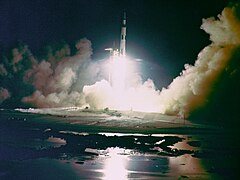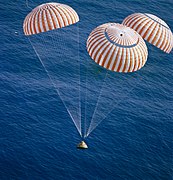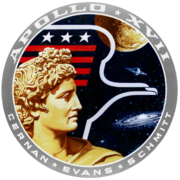Fe, Fi, Fo, Fum, and Phooey


Fe, Fi, Fo, Fum, and Phooey were five mice who traveled to the Moon and circled it 75 times on the 1972 Apollo 17 mission. NASA gave them identification numbers A3305, A3326, A3352, A3356, and A3400, and their nicknames were given by the Apollo 17 crew (Eugene Cernan, Harrison Schmitt, and Ronald Evans). The four male mice, one female mouse, and Evans orbited the Moon for a record-setting six days and four hours in the Apollo command module America as Cernan and Schmitt performed the Apollo program's last lunar excursions.
The mice travelled in individual compartments of tubes inside an aluminium container with "a sufficient food supply, temperature control, and a reserve of potassium superoxide that absorbed the CO2 from their respiration and provided them with fresh oxygen."[1] One of the male mice died (A-3352[2]) during the trip, and the four survivors were euthanized and dissected for their intended biological information upon their return from the Moon.[3]
The three astronauts and the five mice were the last Earthlings to travel to and orbit the Moon.[4] Evans and the five mice share two living-being spaceflight records: the longest amount of time spent in lunar orbit (147 hours 43 minutes), and the most lunar orbits traveled (75).[5]
Mission
Apollo 17 launched December 7, 1972, and returned to Earth on December 19. A biological cosmic ray experiment (BIOCORE) carried the five pocket mice (Perognathus longimembris), a species chosen for the experiment because they had well documented biological responses. Some advantages of the species included their small size, ease of maintenance in an isolated state (requiring no drinking water for the expected duration of the mission and producing highly concentrated waste), and their proven capability of withstanding environmental stress.
Fe, Fi, Fo, Fum, and Phooey had been implanted with radiation monitors under their scalps to see whether they would suffer damage from cosmic rays.[6] Four of the five mice survived the flight; the cause of death of the fifth was not determined.[6]
After their return to Earth, the four remaining live mice were euthanized and dissected. Although lesions in the scalp and liver were detected they appeared to be unrelated to one another, and were not thought to be the result of cosmic rays. No damage was found in the mice's retinas or viscera.[6] At the time of the publication of the Apollo 17 Preliminary Science Report the mice's brains had not yet been examined,[6] but subsequent studies showed no significant effect on their brains.[2]
Gallery
-
 The night launch of Apollo 17, December 7, 1972
The night launch of Apollo 17, December 7, 1972 -
 The Apollo 17 space capsule about to splash down in the south Pacific Ocean.
The Apollo 17 space capsule about to splash down in the south Pacific Ocean. -
 The mice and Command Module America retrieved by the USS Ticonderoga, December 19, 1972 (the three astronauts were already on board the ship)
The mice and Command Module America retrieved by the USS Ticonderoga, December 19, 1972 (the three astronauts were already on board the ship) -
 Mission insignia
Mission insignia
See also
- Animals in space
- Zond 5, a Soviet space program circumlunar voyage in September 1968, by two tortoises and assorted small plants and insects. They were the first Earthlings to fly to the vicinity of the Moon.
- Zond 6, turtles on a circumlunar mission in November 1968
- Zond 7, four turtles flew the August 1969 circumlunar flight
- Fee-fi-fo-fum, the namesake portion of the 1734 English fairy tale "Jack and the Beanstalk"
References
- ^ Conocimiento, Ventana al (December 4, 2019). "The Last Lunar Travellers: Three Humans and Five Mice".
- ^ a b Haymaker, Webb; Look, Bonne C.; Benton, Eugene V.; Simmonds, Richard C. (January 1, 1975). "The Apollo 17 Pocket Mouse Experiment (Biocore)". In Johnston, Richard S.; Berry, Charles A.; Dietlein, Lawrence F. (eds.). SP-368 Biomedical Results of Apollo (SP-368). Vol. NASA-SP-368. Lyndon B. Johnson Space Center. OCLC 1906749.
- ^ Conocimiento, Ventana al (December 4, 2019). "The Last Lunar Travellers: Three Humans and Five Mice".
- ^ Burgess, Colin; Dubbs, Chris (July 5, 2007). Animals in Space: From Research Rockets to the Space Shuttle. Springer Science & Business Media. p. 320. ISBN 9780387496788. Retrieved May 4, 2016.
- ^ "APOLLO 17". history.nasa.gov.
- ^ a b c d Bailey, O.T.; et al. (1973). "26. Biocore Experiment". Apollo 17 Preliminary Science Report (NASA SPP-330).
External links
- Space exchange, October, 2020
- Unilad article, April 28, 2021
- v
- t
- e
programs
missions
| Orbiters |
|
|---|---|
| Landers | |
| Rovers | |
| Flybys |
missions
| Crewed landings | |
|---|---|
| Orbiters |
|
| Impactors | |
| Landers | |
| Rovers |
|
| Sample return | |
| Failed landings |
|
| Flybys |
missions
| Artemis | |
|---|---|
| CLPS |
|
| Luna-Glob | |
| CLEP | |
| Others |
|
missions
| Robotic |
|
|---|---|
| Crewed |
concepts
- Altair
- Baden-Württemberg 1
- European Lunar Explorer
- First Lunar Outpost
- International Lunar Network
- LEO
- LK
- Lunar-A
- Lunar Lander
- Lunar Mission One
- Lunar Observer
- Lunokhod 3
- MoonLITE
- MoonRise
- OrbitBeyond
- Project Harvest Moon
- Prospector
- Resource Prospector
- SELENE-2
- Ukrselena
- XL-1
- Colonization of the Moon
- Google Lunar X Prize
- List of lunar probes
- List of missions to the Moon
- List of artificial objects on the Moon
- List of species that have landed on the Moon
- Lunar resources
- Apollo 17 Moon mice
- Moon landing conspiracy theories
- Third-party evidence for Apollo Moon landings
- Apollo 11 anniversaries
- List of crewed lunar landers
- Missions are ordered by launch date. Crewed missions are in italics.

















